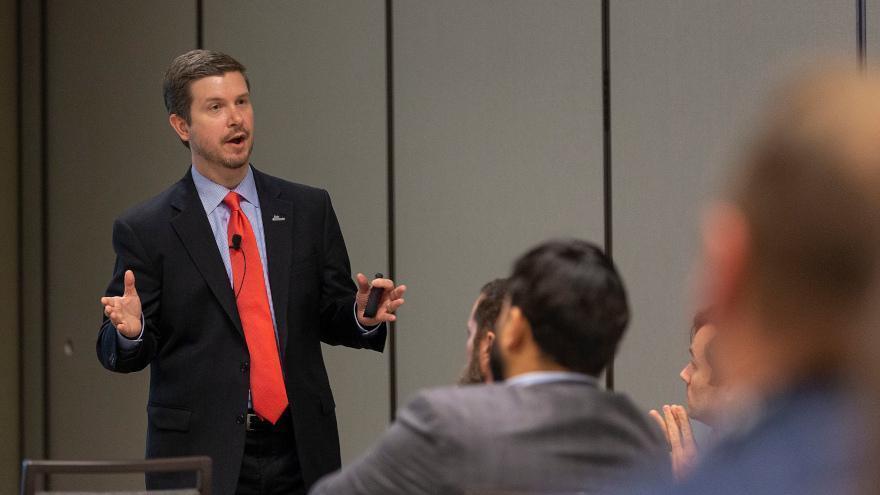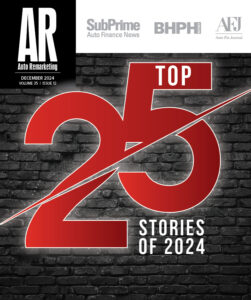Insights into end-of-year used-car market

File photo of Cox Automotive chief economist Jonathan Smoke speaking at the Auto Intel Summit in a prior year. Photo by Jonathan Fredin / Cherokee Media Group.
Used-car sales are down, prices are up and pre-owned retail inventory continues to expand — slowly but surely.
Cox Automotive chief economist Jonathan Smoke, senior economist Charlie Chesbrough and the Industry Insights team drilled down into these trends on the company's Q3 Industry Insights and Forecast Call on Wednesday.
The team found that used-vehicle sales were down 11% in Q3 from 2021 rates, but Cox Automotive pointed out used sales are showing some relative strength going into the fall selling season.
The lower sales in used matched 2019 levels for this time of year — if you can even remember the pre-COVID auto market.
Cox Automotive’s new report showed that in Q3, affordability in the used-vehicle market still remains a concern as prices remain high and interest rates are inching up. Specifically, monthly payments were up by 42% since pre-COVID levels. Cox analysts foresee monthly payments will be up by 47% by end of year.
Smoke shares this is “potentially wiping out pent-up demand.”
And even though used inventory may be rising, this movement is not being reflected in used-vehicle retail sales as high prices are a deterrent for many customers.
Used-vehicle inventory was higher by 10% over last year, according to Cox Automotive data. And used prices were up by 8% over 2021 levels in Q3.
“The ages of the vehicles that (are selling better) are actually a lot older … so we are looking at 2005s and older selling more currently,” Smoke said.
“The other tranche that we have is just below this 10-year old limit, which is the 5- to 8-year old vehicles. So, what we are seeing is the age of the vehicles is straddling this 10-years-of-age number,” he said. “It’s actually the older stuff that’s selling more.”
Third-quarter auto financing data supports the shift toward used vehicles, as well. According to Experian’s State of the Automotive Finance Market Report: Q3 2022 showed 61.78% of all vehicle financing was for used vehicles. That’s up from 58.48% in Q3 2021.
Experian discovered the shift back to used vehicles was present across all credit tiers, though near prime saw the largest increase, going from 72.3% in Q3 2021 to 77.69% in Q3 2022.
During the Q&A portion of the call, auto loan rates were a big concern to listeners.
Before the most recent Fed meeting, Smoke shared the industry was roughly at a 11% weighted average interest rate for used transactions, and that rate might even be higher when looking at certain pools of buyers based on income and low credit scores.
“We think the Fed moves this month through the end of the year are going to move us to potential 9% (for new) and 13% (for used) by year end, which gets us back to 2001 levels,” Smoke said.
This rate conversation led to a discussion on leasing, and how the expected increase in leasing rates has not materialized as previously predicted. The leasing market greatly impacts used inventory, and in turn impacts pricing and other areas of the industry, such as wholesale market health, as well.
Chesbrough said, “We have a wealthier buyer market, better credit; that’s not your typical lease person. Your typical lease person is looking to escape a high payment.”
The market has also seen high residual values over the last year, but those residual values were not passed onto the consumer. Consumers that were aware of this appreciation were buying up their vehicles instead of entering into another lease.
Analysts said this trend can be potentially turned around by the industry if they get more aggressive with their leasing portfolios and begin passing on some of those residual values to consumers.
“It seems to me that there are going to be chances for the industry to tweak their leasing offering here in the fourth quarter to try and stimulate (leasing) sales,” Chesbrough said.
Smoke chimed in, noting that the decline in the leasing market is due in part to the fact that lease deals are essentially not attractive to the consumers that are typically “serial leasers.” And there are chances for the OEMs to turn this around.
On the wholesale side of things, the presentation that accompanied the conference call showed inventory rates are declining slightly more than normal since June.
In terms of wholesale supply, Smoke said that although it’s not quite as tight as new-vehicle inventory, wholesale supply has still been down — especially when compared to used-vehicle inventory on the retail side of the market.
Smoke said, “The biggest source of decline was lease vehicles no longer showing up at auction, because they were increasingly being bought by the consumer or by the grounding dealer.”
And Cox forecasts wholesale supply is going to take another “step down” in the first half of next year.
Looking forward to the end of the year, Cox expects 2022 to end with a large decline in used-vehicle sales, citing high prices, higher rates, less trades, no stimulus checks and more as the catalysts behind this expected decline.
Lastly, Cox Automotive shared its updated 2022 forecasts for crucial areas of the used market during the Q3 call. Here are their predictions, with comparison to what the company predicted in Q2:
- Cox Automotive forecasts overall used-vehicle sales to come in at 36.3 million: Down from Q2 prediction
- Cox foresees 19.1 million used retail sales for the full year: Down from Q2 prediction
- CPO sales are expected to come in at 2.4 million sales: Up from Q2 prediction
- Lease penetration is expected to reach 19%: Down from Q2 prediction
- Cox contends the December 2022 year-over-year Manheim used-vehicle value index to show a 14% drop: Down from Q2 prediction

 View The Latest Edition
View The Latest Edition

